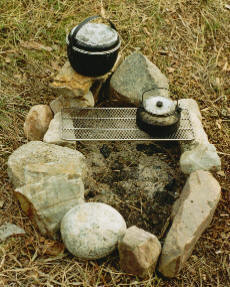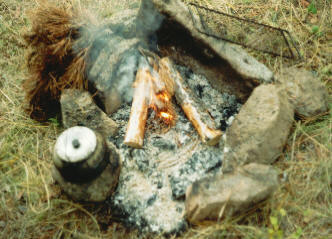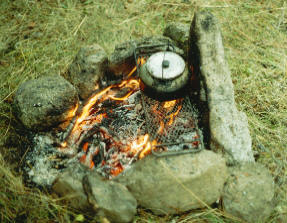
Purcell Trench Company
home grills about order contact
Grill Tips: 2025
"Building a campfire and cooking a meal on it is the essence of camping and the definition of woodcraft." Sly Creek
Campfire use requires knowledge, care and responsibility. In recent years, wildfires have become more frequent, larger, more destructive and dangerous in North America and around the world.
Remember: You are responsible for campfire!
When you are done with your fire, try to let it burn to ash, mix with water and stir. Evening fires are much safer than morning fires. If the day looks warm and dry, I do not build morning fires.
I live and mostly camp in western North America, in rocky country.
Those popular car camping grills with stakes you pound in the ground and
slide your adjustable grill up and down sometimes don't work in rocky
country. Beware of grills with legs or stakes at the corners.
Generally, at least one corner has ground too soft or hard.

Most campfire cooks start with some sort of structure to house the fire. Trenches or rock rings are popular. The tubular, stainless steel Streamside Voyageur grill in the photo is 7 x 18 inches. The ring is oblong so the fire can be hotter on one end and cooler on the other. Coals are pushed under or raked out from under the grill as necessary. Note flat rocks for resting pots and pans. A grill and rock ring this size are fine for a family, or two or three couples. The fire ring serves two purposes. First, it provides a stable platform for the grill. In most instances, you do not want a grill with legs. The rock ring is more stable and dependable. Second, the ring helps control the fire.
Heat gets from the fire to your food in three ways - conduction, radiation and convection. When you put food on your hot grill the sizzle you hear is conduction at work. The cooking food not in contact with the grill largely reflects the work of radiant heat. If you get down on your hands and knees and look across the fire you can see the rising hot air. If you take the rocks away the column gets narrower and drifts all around with every little shift of air current. This is convection heat and you use the rock ring to control air going into the fire and rising off of the fire, like a Weber kettle barbecue, only not as efficient. Grills with legs and suspended from tripods lack control of convection heat unless you build the fire in a trench or build a rock ring around your fire, in which case you do not need the legs or tripod.
I own a collection of camping books. The older ones fill many pages telling how to build fires with bowed sticks, fire drills, flint and steel, magnifying glasses, or a single match. Detailed descriptions tell how to create fuzzy sticks, tinder teepee fires, fire pyramids; the strengths and weaknesses of dozens of different types of fuel woods. There are rigid prescriptions to "never broil meat over fire from evergreen trees" or "never use river rock for building your fire ring." Some of the advice is sound, some not.

Fire needs fuel, oxygen and heat. I like to find two dry, larger pieces of wood. They provide mass and support for the tinder. For the chilly and damp October fire to the left, I used a small hunters saw to cut two pine pieces. The tinder was lodgepole pine needle bundles. Gather a good pile. The large pine chunks retain heat, control air flow and keep the tinder from rolling out of order. Soon, small sticks can be added. The two large sticks keep the small fire from collapse and oxygen starvation.

Except for boiling water, cooking is largely done inches over coals. In this photograph, right, the Streamside Travelers Grill is properly located at the back of a modest fire ring, about two to six inches above the fire. This is a hot fire for boiling the kettle with chimney/reflector rock and open front for longer pieces of wood. An active fire is maintained near the opening at the front. Most of the wood fed into this fire (for a couple or solo user) will be a half inch to two inches in diameter. As needed, coals are pushed under the grill at the back of the fire ring. This is why a narrower grill is better, unless you need the surface area.
Campfire heat can exceed 1,000 degrees F., quite a bit hotter than the family stove. It is helpful to cook at home and pay attention to the heat in your pans and burners, test fire heat by holding your hand near the grill. Most good campfire cooks are good cooks. They cook at home and have several recipes they can prepare anywhere.
Here in the West, hiking country is frequently chilly in the morning and it is best to wildlife watch until the sun is up and then cook. Whole grain, natural, cooked cereals with dried or freshly picked fruit, chopped nuts, and a mug of good tea will keep you going. Verlin Krueger, the great long distance solo canoe traveler, insisted pancakes were real adventure food. Packaged mixes are OK, but it is easy to make your own of whole grain flour. I like to carry a few eggs anyway. I also carry real maple syrup, and organic molasses for buckwheat cakes. I carry more syrup and heavy moisture items if traveling by canoe and less if traveling by bike or foot.
I enjoy baking bread on the trail. You can use a pan (I like Pam Banks' fry/baking pan www.frybake.com) or bake right on a Streamside grill or flat rock.
Dinners are a larger challenge. I like to take frozen meat for the second day of a trip. Broiled chops or steak with grilled vegetables is great trail food. An occasional trout, grouse or rabbit is superb. For thousands of generations people were hunters and gatherers. Make sure you follow state, provincial or other applicable rules before hunting or gathering. Using local foods will make you feel more at home and a part of nature.
Stir fry dinners are always good. Dried vegetables, herbs and seasonings with pasta or rice is fine. Play with some recipes at home. If you like a little wine in the sauce, bring some along. In much backcountry, vast quantities of dead and down wood exists because of a century of overzealous fire control. If going to such places take along lentils, beans, dried meats and so on. Longer cooking times become practical when an overabundance of wood is present. A meal of beans with dried bacon over skillet corn bread is impossible to beat.
There are times when you camp late, weather is bad and you just want some calories. Always take time to eat prior to bed, especially if weather is cold. I take along at least one instant-cook meal and spare ready-to-eat foods for those occasions. I make some of my own, such as jerky and pemmican. I always take nuts, dried fruit, cheese, and candy.
For times when campfires are not appropriate, I take along a naked Trangia alcohol burner. I like to carry a small kettle (Trangia), small pot and a skillet or Banks frybake. You can do about anything with this trio.
Unfortunately, some backcountry travelers treat eating as a burdensome necessity. Take the time to learn campfire and campfire cooking basics. You won't be sorry.
Josh Drake, August 2024
Purcell Trench; P.O. Box 7; Addy, WA 99114 509-680-5958 [email protected]